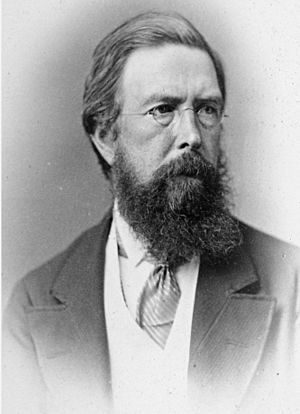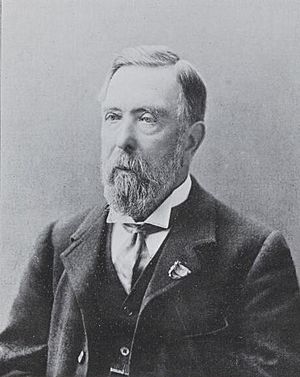Charles Todd (pioneer) facts for kids
Quick facts for kids
Sir Charles Todd
|
|
|---|---|
 |
|
| Born | 7 July 1826 Islington, London
|
| Died | 29 January 1910 (aged 83) |
| Resting place | North Road Cemetery, Adelaide |
| Monuments | The Sir Charles Todd Observatory, the Sir Charles Todd Building |
| Nationality | Australian |
| Education | Greenwich |
| Occupation | Astronomical and meteorological observer, and head of the electric telegraph department. |
|
Notable work
|
Building the first telegraph line across Australia |
| Spouse(s) | Alice Gillam Bell |
| Children | Elizabeth, Charles, Hedley, Gwendoline, Maude, Lorna |
Sir Charles Todd (born July 7, 1826 – died January 29, 1910) was a very important person in Australia's history. He was an astronomer, a weather expert, and a leader in setting up electric telegraph systems. He worked at the Royal Greenwich Observatory and Cambridge University before moving to South Australia in 1855. There, he became the head of the electric telegraph department.
Contents
Early Life and His Work with Time and Telegraphs
Charles Todd was born in Islington, London. His family soon moved to Greenwich, where his father was a merchant. Charles spent most of his early life and got his education in Greenwich.
In 1841, he started working at the Royal Observatory, Greenwich. This was a special chance because the Astronomer Royal, Sir George Biddell Airy, had new money to hire young people. Their job was to be "computers," which meant they analyzed and published old data from the observatory. While there, Charles was one of the first to observe the planet Neptune in 1846.
He then became an Assistant Astronomer at the Cambridge Observatory in 1847. He used a powerful telescope there. He was also the first person to take special early photographs called daguerreotypes of the Moon through this telescope. At Cambridge, he also learned a lot about using the electric telegraph.
Just before moving to Australia in 1854, he was put in charge of a new department at Greenwich. This department focused on using the electric telegraph to send time signals.
Why Time and Telegraphs Were Important
During Charles Todd's time, railways were growing fast. Trains needed exact timetables and signaling systems. This meant that different towns couldn't just use their own local time anymore. A standard time, like Greenwich Mean Time, became very important.
The electric telegraph was a new invention that could send information almost instantly. This was perfect for sending accurate time signals. The Greenwich Observatory connected to a nearby telegraph line. This allowed the observatory to send precise time to railway companies. It also helped them control clocks and time balls (which dropped daily to help ships set their clocks) in places far away.
Charles Todd even helped a team use the electric telegraph to figure out the exact longitude (east-west position) of Greenwich and Cambridge. This showed how useful the telegraph was for science.
Arriving in Australia and Building Telegraph Lines
In 1855, Charles Todd, along with his 19-year-old wife Alice Gillam Bell, arrived in Adelaide, South Australia. Alice Springs was later named after his wife! When he arrived, his department was very small and didn't even have a single telegraph line yet.
His first big job was to build a telegraph line between Adelaide city centre and Port Adelaide. This line opened in February 1856. Soon after, he suggested building a line all the way from Adelaide to Melbourne. Charles Todd even rode across much of the land himself to plan the route.
He and Samuel Walker McGowan from Victoria worked together. They linked the two colonies' telegraph systems near Mount Gambier in July 1858. Through McGowan, Todd met Joseph Oppenheimer, a German-born inventor who became a lifelong friend and helped Todd with future projects.
The Amazing Overland Telegraph Line
One of Charles Todd's biggest ideas was to build a telegraph line right across Australia, from Adelaide to Darwin. Most of this land was unknown back then. It took many years for Todd to convince the South Australian government that this huge project was possible.
In 1870, the plan was approved. The Australian Overland Telegraph Line would go from Port Augusta in the south to Port Darwin in the north. Other colonies didn't want to share the cost, so South Australia took on the challenge.
The company building the northern part of the line gave up. So, Charles Todd himself had to go north to finish the job. Everything had to be sent by sea and then carted over land. He faced many problems but solved them all. The line was finished on August 22, 1872. This was a huge achievement! It meant Australia could finally communicate quickly with England and the rest of the world.
After this, he also built another important line from Port Augusta, South Australia to Eucla in Western Australia in 1876. Later, his department even replaced old wooden poles with stronger, new ones designed by his friend Oppenheimer.
Leading the Post Office
In 1870, the Post Office and the Telegraph Department joined together. Charles Todd became the Postmaster General, in charge of both. Even though he was busy building the Overland Telegraph, he worked hard to improve the Post Office.
He made changes that helped the employees and improved the services for everyone. His staff respected him greatly. When Australia's colonies joined together in 1901 (called Federation), South Australia's post and telegraph department was the only one making a profit! Charles Todd continued working until 1905, serving for over 51 years.
Studying the Weather (Meteorology)
Charles Todd was also a pioneer in studying weather in Australia and New Zealand. When he arrived in South Australia, he brought special weather instruments. He made sure they were set up to match the instruments at Greenwich.
His most important work in weather began when the telegraph systems were completed in the 1870s. From his office in Adelaide, Todd used weather reports sent by telegraph from all over Australia and New Zealand. He created detailed weather maps that covered a larger area than anyone else in the world at that time.
Todd was one of the first to suggest that local weather could be affected by big global events. For example, he noticed that high air pressure in India often happened at the same time as similar conditions in Australia. This often led to droughts in both places, thousands of kilometers apart. Today, we know this as part of the El Niño-Southern Oscillation (ENSO), which links weather patterns across the globe.
One of Todd's lasting contributions is his collection of 63 "Weather Folio" journals. These books contain weather data from 1879 to 1909. They are now being used by scientists to understand past climates.
The Government Electrician
Charles Todd often called himself the "Government Electrician." He loved promoting electric light in the colony. In 1860, he gave the first public demonstration of an electric arc lamp. In 1867, he lit up a street in Adelaide with arc lamps.
He also helped get electric lighting installed at the 1887 Adelaide Jubilee International Exhibition, which was the first time this happened in Australia. He helped set up the first electrical engineering course in South Australia. Todd also oversaw the installation of electric lights in Parliament House and the main Post Office.
In 1899, Todd and his son-in-law, William Henry Bragg, showed off a wireless communication system. It could send signals over 4 kilometers! Even though it was too expensive to use widely then, it showed his vision for the future.
Astronomical Work
Even with all his other jobs, Todd still found time for astronomy. He used the Adelaide Observatory, which was built in 1860 and had excellent instruments. He made important observations for scientists around the world. These included observations of the transit of Venus (when Venus passes in front of the Sun) in 1874 and 1882, and observations of Jupiter and Mars.
He also helped choose the location for the new Perth Observatory in 1895. He wrote many scientific papers for the Monthly Notices of the Royal Astronomical Society.
Surveying and Time Balls
As the "Astronomical Observer," Todd was responsible for setting the exact position and time for the colony. The precise location of the Adelaide Observatory became a standard point for land surveys.
In 1882, he became the first president of the South Australian Institute of Surveyors. He also helped set the boundary line between South Australia and New South Wales. His calculations even showed a small error in the border between South Australia and Victoria, which led to a long disagreement between the two colonies.
Todd also worked to make time more accurate for everyone. The Adelaide Post Office clock, installed in 1875, became a key timekeeper. He also pushed for a "time ball" to be installed at Semaphore port. This time ball would drop daily, sending an accurate signal by telegraph from the observatory. This helped ship navigators set their clocks precisely, which was vital for safe travel. The Semaphore time ball was completed in 1875 and is still there today.
Later Life and Legacy
In 1885, Charles Todd attended an international telegraph conference in Berlin. The next year, he visited Great Britain and received an honorary degree from Cambridge University. In 1889, he became a Fellow of the Royal Society, a very high honor for scientists.
He continued working for South Australia's post and telegraph services until 1901. At 74 years old, he became a federal public servant when the new Commonwealth of Australia took over these services. He retired in December 1906, after more than 51 years of service.
Charles Todd passed away on January 29, 1910, at his home in Semaphore. He is buried at North Road Cemetery in Adelaide.
Many things are named after him to honor his contributions. The Sir Charles Todd Building at the University of South Australia and the Sir Charles Todd Observatory are examples. The Telecommunications Society of Australia also holds a special "Charles Todd Oration" each year.
The Todd River and Charles River in the Northern Territory are named after him. A waterhole in the Todd River was named Alice Springs, after his wife Alice. This name was later used for the Alice Springs Telegraph Station and then for the town of Alice Springs itself.
Family
Charles Todd married Alice Gillam Bell in 1855. They had six children:
- Charlotte Elizabeth Todd
- Dr Charles Edward Todd
- Hedley Lawrence Todd
- (Alice) Maude Mary Todd
- Gwendoline Todd, who married the famous physicist William Henry Bragg. He and their elder son, William Lawrence Bragg, later shared the Nobel Prize in Physics in 1915.
- Lorna Gillam Todd, who wrote articles about her father.



